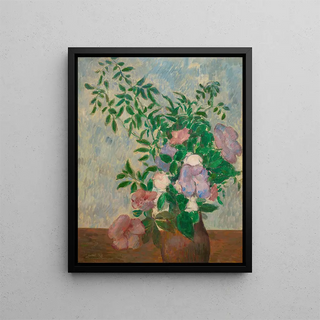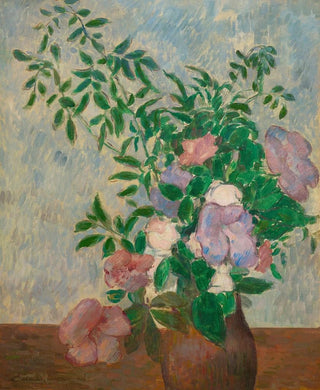Art print | Still life with a vase of flowers - Émile Bernard


View from behind

Frame (optional)
Nature morte with a vase of flowers - Émile Bernard – Captivating Introduction
The still life, often perceived as a simple assembly of inanimate objects, reveals under Émile Bernard's brushstrokes a depth and poetry beyond expectations. "Nature morte with a vase of flowers" is a work that transcends the genre, inviting the viewer to meditative contemplation. In this composition, each element, whether the delicately arranged flowers or the vase that shelters them, tells a story. The light caressing the surfaces, the dancing shadows, and the vibrant colors combine to create an atmosphere that is both serene and dynamic. This painting transports us to a universe where the ephemeral beauty of nature is captured with remarkable finesse.
Style and uniqueness of the work
Émile Bernard's style is distinguished by its innovative approach and its ability to blend tradition and modernity. In "Nature morte with a vase of flowers," the artist uses bold colors and simplified forms, while maintaining a certain delicacy. The flowers, though immobile, seem to vibrate under the effect of warm light, creating an impression of life and movement. Bernard moves away from academic conventions to explore the expressive possibilities of color and texture. This work also demonstrates particular attention to composition, where each element is carefully placed to guide the viewer's gaze and allow appreciation of the harmony of the whole. The juxtaposition of colors, from the deep red of the petals to the soothing blue of the vase, creates a captivating visual dialogue that leaves no one indifferent.
The artist and his influence
Émile Bernard, an emblematic figure of post-impressionism, managed to mark his era with his originality and boldness. Born in 1868, he associated with artists such as Paul Gauguin and Vincent van Gogh, from whom he drew inspiration while forging a style that is uniquely his own. His work reflects an unceasing quest for beauty, a desire to capture the very essence of things. Bernard also played a key role in the development of Cloisonnism, a movement that favors clear contours and flat areas of color. His influence extends beyond his own

Matte finish

View from behind

Frame (optional)
Nature morte with a vase of flowers - Émile Bernard – Captivating Introduction
The still life, often perceived as a simple assembly of inanimate objects, reveals under Émile Bernard's brushstrokes a depth and poetry beyond expectations. "Nature morte with a vase of flowers" is a work that transcends the genre, inviting the viewer to meditative contemplation. In this composition, each element, whether the delicately arranged flowers or the vase that shelters them, tells a story. The light caressing the surfaces, the dancing shadows, and the vibrant colors combine to create an atmosphere that is both serene and dynamic. This painting transports us to a universe where the ephemeral beauty of nature is captured with remarkable finesse.
Style and uniqueness of the work
Émile Bernard's style is distinguished by its innovative approach and its ability to blend tradition and modernity. In "Nature morte with a vase of flowers," the artist uses bold colors and simplified forms, while maintaining a certain delicacy. The flowers, though immobile, seem to vibrate under the effect of warm light, creating an impression of life and movement. Bernard moves away from academic conventions to explore the expressive possibilities of color and texture. This work also demonstrates particular attention to composition, where each element is carefully placed to guide the viewer's gaze and allow appreciation of the harmony of the whole. The juxtaposition of colors, from the deep red of the petals to the soothing blue of the vase, creates a captivating visual dialogue that leaves no one indifferent.
The artist and his influence
Émile Bernard, an emblematic figure of post-impressionism, managed to mark his era with his originality and boldness. Born in 1868, he associated with artists such as Paul Gauguin and Vincent van Gogh, from whom he drew inspiration while forging a style that is uniquely his own. His work reflects an unceasing quest for beauty, a desire to capture the very essence of things. Bernard also played a key role in the development of Cloisonnism, a movement that favors clear contours and flat areas of color. His influence extends beyond his own






